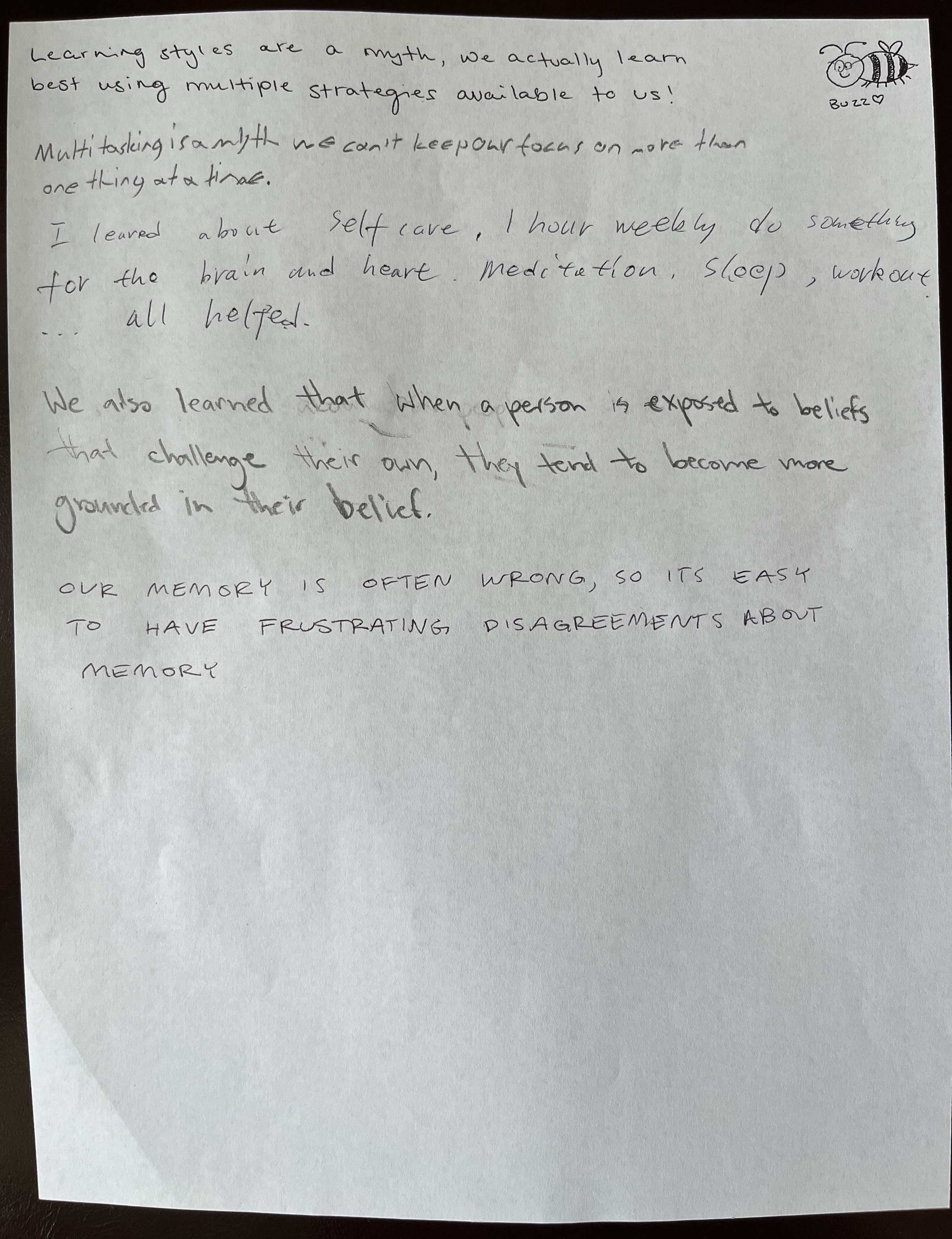Leave One Add One: An engaging class activity for retrieval practice
/By Pooja K. Agarwal, Ph.D.
As we approach the end of the semester and the end of the school year, I want to share one of my favorite activities for retrieval practice: I call it Leave One, Add One. Click here to view and download my Google Slides for this activity.
Time: Approximately 30 minutes total (15 minutes for writing, 15 minutes for discussion)
Grade level: 6th grade through graduate school. You can use this activity during professional development, too.
Content area: All of them! STEM, language arts, history, etc.
Materials: Blank paper and pencils/pens
Leave One, Add One
Here’s are the steps for Leave One, Add One:
Hand out one sheet of blank paper to each student.
Have students draw an animal in the top right corner of the paper (without writing their name down; this is anonymous). Keep it quick; give students only 30 seconds to draw.
Ask students to silently retrieve and write down one idea or concept they’ve learned in class. It can be their favorite thing or the first thing that comes to mind, related to any course material, etc. This should be at least one full sentence.
Collect all students’ papers and explain the process for Leave One, Add One: Students have now “left one” on their piece of paper. Each time they receive someone else’s sheet of paper, they should “add one.” In other words, students should retrieve and write down one new thing they learned in class. This should be something new that isn’t already on the piece of paper, and also something new that the student didn’t write down on a previous piece of paper.
Shuffle students’ papers and hand them back in a random order. When students are done adding one thing, they should hold up their paper for you to collect and re-distribute. While students are writing, the activity is silent and self-paced.
Continue collecting and handing out of papers for a few rounds, until students start receiving papers they have had before (for a class of 20 students, I recommend 5–6 rounds). This self-paced process will get a bit zany as you run around collecting and handing out papers, but it’s a lot of fun, too.
Once you’re done with the rounds, collect all papers. Use the animal drawings to hand back the papers to the original student (you can hold the paper up and call out the name of the animal).
Class discussion: Students should share one thing cool that someone else wrote on their paper. If you’d like the discussion to continue, have students share two things from their paper. You’re done!
Important: Don’t grade the papers! Retrieval practice is a learning strategy, not an assessment strategy. Students can keep their paper as a reminder of what they’ve learned, they can recycle them, or you can collect them just to look at them – but make sure it’s clear that it’s not for a grade. Use Leave One, Add One for spaced retrieval practice and boost students’ long-term learning.
More context and tips:
Before I start, I tell my students that this we have a pop final exam (I’m just kidding! Click here for my Google Slides I use in class). Some students groan, while other students catch on quickly that I’m joking.
Some of my students automatically write their name on the piece of paper as soon as they receive it. Why? Now that my college students have had an entire semester with me and they’ve learned about retrieval practice, I make light of the situation: I explain that, in our educational systems, we are so used to grading everything that it’s become an ingrained habit for students to write their name down. If a student wrote their name down, give them a new blank sheet of paper so that the activity is anonymous.
Reminder: For retrieval practice, silence is golden. Encourage students to write silently until writing ends and class discussion begins.
Scaffolding: During class discussion, each student is reading one thing that’s on the paper in front of them, so they’re not put on the spot. This can be particularly helpful for English language learners and students who need more time to think.
Examples of Leave One, Add One from Dr. Agarwal’s class
Quick Teaching Tip for Class Discussion
During class discussion, when a student is speaking, walk to the other side of the classroom. The student will naturally start talking more loudly and all students in the classroom will feel included in the conversation.
Credit: Leave One, Add One is my adaptation of an activity called “ink shedding,” attributed to James Lang, author of Small Teaching and On Course. The quick teaching tip to improve class discussion is also from James Lang. On Course is one of my favorite teaching books of all time. Make sure to add his books to your summer reading list.
How to Bulk Order Powerful Teaching
Many of you have asked how to bulk order Powerful Teaching using ESSER funds and/or for summer book clubs (thank you!).
For bulk orders (hardback and e-book), email Victoria Finley, Account Manager at Wiley Publishing, at vfinley@wiley.com. Discounts range from 25% – 40% off, depending on the size of your order.
For exclusive resources for book clubs, email my co-author Patrice Bain at patrice@patricebain.com.
Join our Powerful Teaching Facebook group and download our free lesson templates
Powerful Teaching is available in hardback, e-book, audiobook, and also in Spanish
Help us: Leave a rating or review on Amazon for Powerful Teaching
I acknowledge that promoting book sales and requesting Amazon reviews is awkward. The reason for my request is that providing Powerful Teaching to teachers supports their long-term learning and classroom implementation with a tangible resource. I have found that this approach is much more effective than "one and done" professional development. I receive less than $1 per book sold, so it’s not about the money. It’s genuinely about sharing the science of learning around the world. Thank you for your support!






























